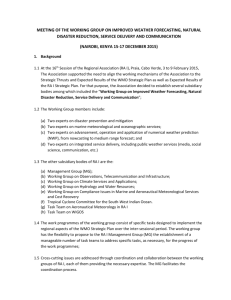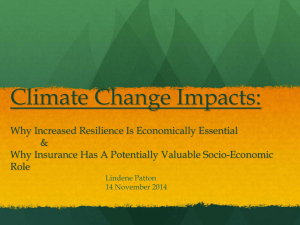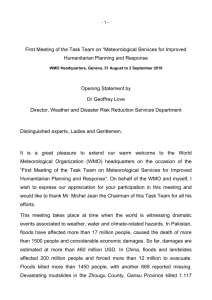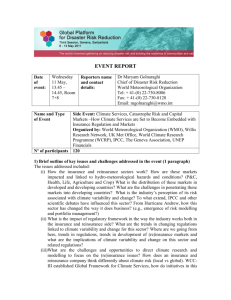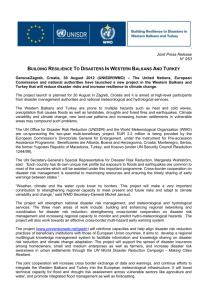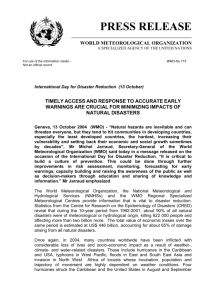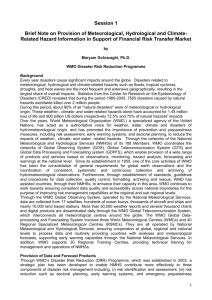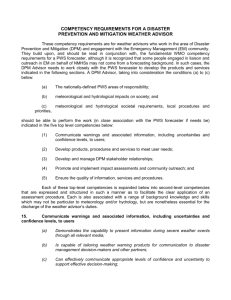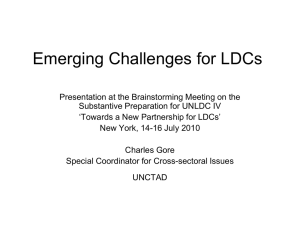WMO presentation
advertisement
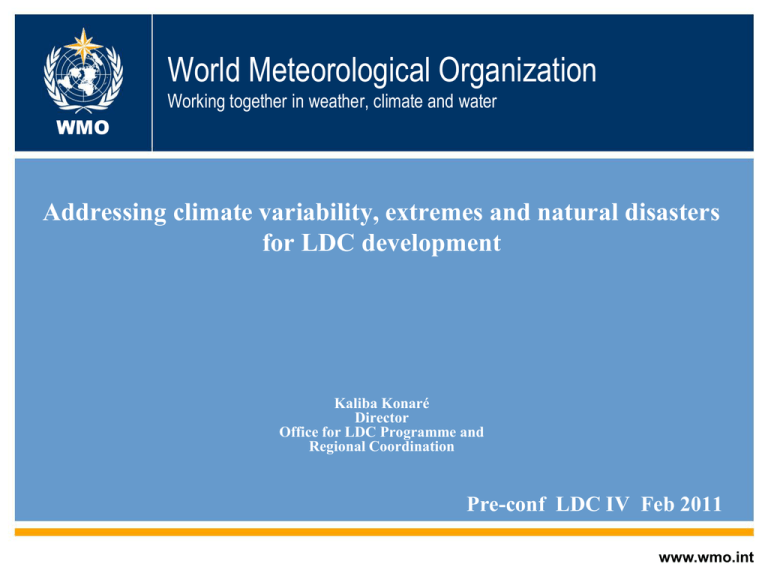
World Meteorological Organization Working together in weather, climate and water WMO Addressing climate variability, extremes and natural disasters for LDC development Kaliba Konaré Director Office for LDC Programme and Regional Coordination Pre-conf LDC IV Feb 2011 Kisumo, Kenya www.wmo.int WMO A complementing approach Climate Change: key challenge Way it impacts LDC development through • weather and climate extreme events (related hazards) • climate variability • Damages to Society Action/ Informed decision making Seamless climate information services for CC Adaptation and reducing vulnerability 1 Current Climate Variability Within a year Runoff Current Climate Variability Across years Development impact of climate variability IPCC 4th Assessment: Socio-economic Impacts of Climate-Related Extremes on the Rise ! Energy Hazard intensity and frequency increasing linked to climate variability and change! Transportation Water Resource Management Intensity Strong Wind People Heavy rainfall / Flood Agriculture Urban areas Vulnerability and exposure on the rise ! Drought Need for Multi-sectoral risk management Heatwaves Frequency Increase of reported natural disasters is weather related Billions of USD per decade Geological 495 500 Hydrometeorological 450 400 345 350 300 While economic losses are on the way up! 250 200 150 50 0 11 4 56-65 24 14 66-75 Geological 47 76-85 86-95 96-05 decade 2.66 Hydrometeorological 2.5 2 1.73 1.5 1 0.67 0.65 0.39 0.5 0.05 0 103 88 100 Millions of casualties per decade 3 160 56-65 0.22 0.17 66-75 Source: EM-DAT: The OFDA/CRED International Disaster Database 76-85 0.25 86-95 0.22 96-05 decade Loss of life from hydrometeorological disasters are decreasing! Many LDCs are still in post-disaster response COMMUNITIES AT RISK National Government (emergency systems) disaster response Disaster response National Technical Services Meteorological Hydrological Geological hazard warning Marine Health (etc.)… Local government Early Warning Systems Require Coordination Across Many Levels and Agencies National to local disaster risk reduction plans, legislation and coordination mechanisms 1 3 2 4 There is need for investments in all Components of Early Warning Systems ! 1 National Government DRR coordination mechanisms Aligned policies, plans, resources, coordination 4 warnings 4 feedback 5 5 Capacity Development and Coordinated National Technical Agencies 2 Meteorological 4 warnings Hydrological feedback Geological Marine Health, Agricuture (etc.) 5 Local Government responsible for emergency preparedness and response 3 Community Prepared • Need to provide relevant weather, water and climate information and services to Disaster Risk Management programmes. • Science-techno progress: new era for LDCs: - weather forecasts - seasonal to annual climate outlook - Climate change scenarios Climate information for Disaster Risk Reduction Operation Clim Info Provider Disaster Managers Location Vulnerability Magnitude Expected Loss Lead Time Range of plausible actions Probability Subjective decision to act or not act Meeting the challenges – New PoA for LDCs • As – Assist LDCs to strengthen their National Meteorological and Hydrological Institutions and raise their profile within the government national development framework, including productive capacity in key sectors climate change adaptation and productive capacit – Integrate investment and resources as a complementing , not substituting, support system to climate change adaptation, including NAPA, UNCCD, and to productive capacity in key socioeconomic sectors – Develop cooperation between the governments, WMO and other UN agencies, development banks and donors 14 THANK YOU
